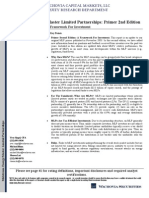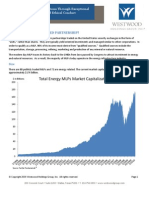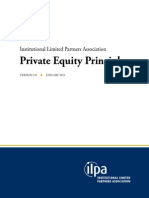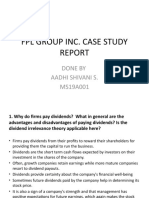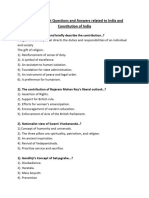MLPs: The Essential Guide
MLPs, or Master Limited Partnerships, are an interesting option for income investors that can offer higher yields than most dividend stocks. MLPs were formed in the U.S. in the early 1980s. They are publicly traded partnerships. Back then, there were much higher top marginal tax rates than there are currently, and so investors were particularly interested in tax-advantaged businesses. The MLP structure allowed businesses to spin off portions of their assets in a very taxadvantaged situation, and allowed individual investors to benefit as well. But the structure was so attractive in terms of taxation, that practically every business would want to be a MLP, and so in 1987, the government restricted which kinds of businesses can exist as MLPs. For the most part, only real estate, natural resource, and interest/dividend income can now be held in MLPs. At least 90% of the income of the MLP must be from these qualifying sources. Most of the MLPs I refer to in this guide invest in natural resource infrastructure. Some of the best ones, in my opinion, are the ones that invest in gas pipelines and other longterm infrastructure, since they can provide rather reliable cash flows for distribution growth. These projects have large capital expenditures, high barriers to entry, partial natural monopolies once theyre built (like a utility), and generate rather stable cash flows. Core Reading: The Structure of MLPs What to Look for in a MLP
Should You Invest in MLPs?
There are advantages and disadvantages to investing in MLPs. -Master Limited Partnerships can offer fairly high distribution yields that are also reasonably safe and reliable. When combined with some core dividend stocks, they can really boost the yield of a dividend portfolio. -MLPs are fairly tax-advantaged since taxes are relatively modest and partially deferred. -Although there are tax advantages, MLPs do complicate the tax filing, because you need to fill out an additional form. If you own quite a large investment, you may find yourself owing taxes in other states. So, there are some pros and cons of investing in Master Limited Partnerships. Personally, I find them to be great investments as part of a diversified portfolio. I wouldnt recommend investing in them if you only have a little bit of cash, but if you can commit a few thousand dollars to an investment, then MLPs might be an attractive option for you.
�The Structure of MLPs
This is part of MLPs: The Essential Guide. The structure of MLPs can vary to some extent, but the basic structure is this: There exists a General Partner (GP), that consists of the management team, and Limited Partners (LPs), that contribute capital. Often the entity that holds the GP also holds some LP units. Limited Partners contribute capital by buying units of the MLP. (Theyre called units rather than shares.) These LP units can then be traded on an exchange. In return, the LPs receive distributions from the operations, which are like dividends. The GP often has Incentive Distribution Rights (IDRs) that are set forth in the founding of the partnership. The IDRs give the GP a ton of incentive to raise the distribution over time for the units that the LPs hold. These partnerships, therefore, are specifically designed for distribution growth. A typical IDR structure starts off with the GP receiving 2% of the cash flow from the MLP, while the LPs receive the other 98%. For example, the MLP may start off by paying $0.25 per quarter to each LP unit as a distribution, with the GP only receiving a small sum. There will then be pre-defined tiers for which the GP starts getting paid a bigger share. In this example, the structure may be that once the per-unit distributions reach $0.35, the GP begins receiving 15% of the cash flow above that point, with the LPs receiving the other 85%. And then if the distribution reaches $0.45, the GP begins receiving 25% of the cash flow above that point, with the LPs receiving the other 75%. And then finally, if the distribution reaches $0.55 or above, the GP receives a full 50% of the cash flow above that point, with the LPs receiving the other 50%. Its tiered, so management receives the pre-defined percentage of the total cash above that tier. So as an example, if the partnership reaches $0.39 in distributions per unit per quarter, that doesnt mean the GP receives a full 15% of the cash. They receive 2% of the cash below the tier, and then 15% of the cash above $0.35. Kind of like tax brackets. The purpose of IDRs is to align management interest with limited partner interest. As management increases the per-unit distributions to the LPs, their own share of the cash grows even more quickly. So while Limited Partners may not particularly enjoy giving a lot of money to the GP at later stages in the MLP, it would be hard for them to complain, because if they get to that point, theyve likely outperformed most other investments. The agreement is designed to give incentive to the GP to raise quarterly distributions far beyond the final tier. To grow the business, the General Partner will usually issue new units. This is the opposite of corporations, that if they are shareholder friendly, typically wish to avoid share dilution and even repurchase their own shares to reduce the number of shares outstanding. Since MLPs are tax-advantaged, however, if they can get more capital, they can generally provide good returns to all new and existing unitholders.
An Example
This can be demonstrated with a rather simple and clear example.
�Suppose there exists an MLP that currently has 100 million units, and each unit costs $50 and pays out $3 in annual distributions for a 6% yield. The market capitalization of this MLP, therefore, is $5 billion, and it pays out $300 million in distributions per year out of the $330 million in total free cash flows that it generates. The MLP is paying out most of its cash flow, and so there is little capital left to grow the business and the distribution. However, management has a good growth opportunity: they can build a pipeline that connects from their network to a storage hub, and all of their research indicates that this will be a good investment. It will cost $2 billion to build, and will produce $300 million in annual cash flow that grows at least with inflation, and will have $100 million in annual capital expenditures and maintenance. In addition, they can finance part of the construction with $1 billion in debt at 5% interest, since the assets should produce very reliable cash flows. So for this investment, theyll have to pay $1 billion in upfront costs, and theyll receive $300 million in cash flows and have to pay $100 million for expenditures and maintenance and $50 million in interest, for a total remaining profitable cash flow of $150 million. This would be a 15% return on their $1 billion in upfront equity. The MLP makes this investment by issuing 20 million new units at $50 per unit. So now, there are 120 million units, and the partnership is bringing in $480 in free cash flow (the original $330 million plus the new $150 million). Management calculates they can pay out $450 million as distributions, which divided up into 120 million units equals $3.75 per unit per year (paid quarterly), which is a 25% increase over the original distribution of $3. So they managed to pay higher distributions to more units. Pretty impressive.
Conclusion
Thats generally how MLPs grow. They continue to make new investments in the form of new construction or acquisitions funded by issuing units, and if management is good, theyll make sure that the new investments that they issue new units for are beneficial to everyone. In reality, the example would be a bit more complicated, because wed have to factor in the incentive distribution rights to management. We cant really expect a 6% distribution yield and continued 25% distribution growth, but its not unreasonable to expect mid-to-high single digit distribution yields and mid-to-high single digit distribution growth for total annual returns in the low double digits. As far as dividend stocks go, this is pretty good. The main emphasis on MLPs is that their structure is beautiful for the general partner, and pretty good for the limited partners as well. The tax-advantaged structure allows for rapid new capital additions in the form of new units issued, and the IDRs of the general partner encourage this type of growth as much as possible.
�What to Look for in a MLP
This is part of MLPs: The Essential Guide. There are a few key areas where MLPs can be fairly attractive for individual investors alongside other investments like dividend stocks. First, unless youre a particularly interested and savvy investor, Id propose sticking to fairly stable businesses. The fairly stable MLPs tend to be pipeline businesses and other very reliable cash-generating assets. Second, there are three key areas for MLPs I look for. They are: MLPs on the low side of the IDR payouts, publicly traded General Partners, and MLPs with no General Partner.
1) MLPs on the Low Side of the IDR Payouts
As previously mentioned, the MLP typically starts out with very low Incentive Distribution Rights (IDRs) payments to the General Partner. This means that the cost of capital is low, and limited partners receive almost all of it. Over time, if management is good, the partnership will grow considerably and the distributions per unit will grow considerably. At this point, the GP is getting a big share of the total cash flows. This can be somewhat problematic at this point, since future growth relies on continued issuance of new units for construction or acquisitions. If a considerable portion of the cash from these new investments goes to the GP, then it can be difficult to find investments that allow the MLP to raise the distribution for all Limited Partner units. This isnt necessarily an insurmountable problem; there have been established and large MLPs that continue to make good investments for unitholders despite being on the high end of their IDR targets. But they may be an exception to the rule. So when youre investing in an MLP as a Limited Partner, make sure youre aware of what the IDR agreement is, and where the distributions currently stand in relation to the target distributions. Investing in young MLPs means Limited Partners receive a big share of the cash, and there is plenty of incentive to the General Partner to grow the partnership and increase the distributions. These young MLPs can potentially produce a rather good rate of return for a number of years, and potentially a lot longer than that.
2) Publicly Traded General Partners
Sometimes, the General Partner is itself wrapped in a partnership structure and traded on an exchange. This means that investors can benefit from the growth of the General Partner and the IDRs. Investors in a General Partner can be on the receiving side of the IDRs rather than the paying side. Astute readers have noticed two things by now: 1) The GP benefits when it raises distributions per unit, since they reach their IDR targets and start getting a bigger percentage of the total cash. 2) Since their IDR agreements allow the General Partner to take a percentage of the total cash flow, they also benefit when the partnership as a whole, issues more units and
�grows, since there will be more total cash flow, and they get a pre-defined percentage of total cash flow. In other words, the General Partner benefits both in the sense that it gets a greater share of the total cash pie as it performs well, and also that it grows the size of the cash pie. The General Partner, therefore, wants to issue as many units as possible to grow the MLP as big as possible, while also ensuring that all of those investments allow them to grow the per-unit distributions to the Limited Partners, so that they can reach and surpass the highest tier of their IDR distribution agreements. This is why MLPs are so good at building infrastructure like wildfire: management benefits insanely from profitable growth and has tons of incentive to collect as much new capital for investment and growth as possible. So the General Partner starts out receiving approximately 2% of a small MLP cash flow, and if they manage the partnership skillfully, they end up receiving perhaps 20% or 30% or more of a much, much larger MLP cash flow. The total returns can be rather incredible for the GP, and some of them are publicly traded. These publicly traded GPs sometimes exist as independent investments, where investors receive distribution payments that hopefully grow strongly. Other times, the GP is held by a larger company, so the investor benefits from their wholly owned operations, as well as their GP interest in a partnership. I find General Partners to be a great investment for the most part, because investors can generally expect significant distribution growth, and they benefit both from increased distributions and an increase in the number of LP units due to issues of new units, but they are not without drawbacks. Firstly, there arent too many pure publicly traded GPs anymore, since a lot of them have been bought out (which can be good for the holders of those GPs, and for the potential of existing holders of GPs). So pickings are limited. There are still some, and above that, there are many companies that include a GP interest in with the rest of their assets. Secondly, along with increased reward, comes increased risk. The limited partners have a fairly straightforward risk profile: their partnership generates cash, and they get some of it. If the partnership generates less cash, the distribution will likely have to be cut. But for a general partner, this can be more dramatic, because if the distribution is cut, it will likely fall lower in the IDR tier structure, and theyll receive a smaller percentage of the now-smaller total cash flow until they can increase the distribution again. So in the event of a problem, the General Partner has more downside risk than the Limited Partners. Theyre leveraged on the performance of the whole partnership; then things are good, they do great, but when things are bad, they do worse. This is partially mitigated by the aforementioned companies that hold their own assets as well as a GP interest in a partnership.
3) MLPs with no GP or Low IDR Caps
As previously mentioned, at high levels, the IDRs can sometimes be a limit on growth, since it basically increases the cost of capital and makes it more difficult to find investments that benefit both the GP and the LPs. Investments only make sense from the perspective of the Limited Partners if, even after IDR payouts to the GP, they can
�still raise LP distributions. The higher the incentive distribution payouts become, the harder this is to do. MLPs typically solve this problem in one of three ways: 1) Management is excellent, and is able to continually find these investments. 2) The partnership buys out the General Partner. The GP benefits because they receive a good buyout, and LPs benefit because from this point forward, there are no Incentive Distribution Rights to pay out anymore, and so they have a much lower cost of capital for new investments to increase the partnership and the distributions. 3) The partnership solves this problem from the beginning, and caps IDR payouts to 25% of total capital rather than 50%. Up to 25% or so is rather sustainable; the GP benefits, but they never get so much that it hurts the partnerships ability to find good investments. Finding partnerships that either no longer have to pay any IDRs, or finding partnerships that only have to pay small IDR payments, can make for a fairly attractive investment.


